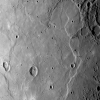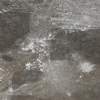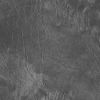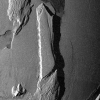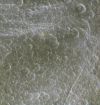Emily Lakdawalla • Dec 24, 2010
Door 24 in the 2010 advent calendar
Time to open the twenty-fourth door in the advent calendar. Until the New Year, I'll be opening a door onto a different landscape from somewhere in the solar system. Where in the solar system are these squirrelly spots?

This is the so-called "Swiss cheese" terrain of Mars' defrosting southern polar cap. The southern polar cap expands each year in the polar winter as a sizable fraction of the planet's carbon dioxide atmosphere freezes onto the ground. I'm going to shamelessly steal a bit of text from Ryan Anderson's Martian Chronicles blog (which recently moved to the AGU's stable of blogs-- congrats, Ryan!) to explain the origin of this terrain. In the text below, Ryan was describing a talk at a conference by Shane Byrne.
It is part of a slab of dry ice that is gradually turning back into gas. As it sublimates, the terrain develops really weird textures: the lower-elevation pits in the carbon dioxide layer are like holes in a slice of Swiss cheese. Byrne came up with a computer model that shows that, weird though it may look, the Swiss cheese terrain is just the result of normal cycles of deposition and sublimation of carbon dioxide. The cycle works like this: start with a flat area and start depositing dry ice on it from the atmosphere. Inevitably, there will be some places that get a little more than other places, and the surface will become more rough. Once roughness gets started, it will become exaggerated as more carbon dioxide is added (maybe a rough spot that gets less sunlight will accumulate a little more carbon dioxide). Eventually, pits form in the carbon dioxide layer where more carbon dioxide sublimates than condenses. Once the pit reaches through the carbon dioxide layer, it grows and grows, until it meets up with other pits and eventually the carbon dioxide layer is eaten away. Pretty cool stuff. A key factor in his models is that dust storms can change the rate at which carbon dioxide is deposited, so they can have a big influence on how the Swiss cheese terrains form and evolve.
My favorite aspect of this image is its imperfectly fractal nature -- zoom in and you can see that there's at least two scales of these arcuate defrosting features. If you go check out the full image at the HiRISE website, you'll find that the Swiss cheese terrain was just tangential to the subject of the photo, which was actually an enigmatic circular feature within the residual polar cap that's been a mystery since Mariner 9 first imaged it.
The Planetary Society Blog 2010 Advent Calendar
The Time is Now.
As a Planetary Defender, you’re part of our mission to decrease the risk of Earth being hit by an asteroid or comet.
Donate Today

 Explore Worlds
Explore Worlds Find Life
Find Life Defend Earth
Defend Earth



